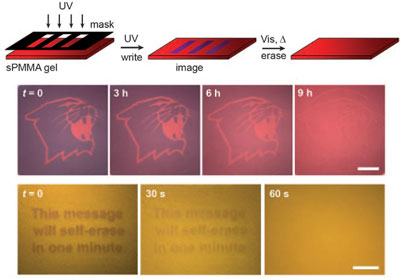| Posted: Sep 15, 2009 | |
This message will self-destruct in five seconds... |
|
| (Nanowerk Spotlight) A hallmark of the Mission: Impossible series shows secret agent Phelps receiving his instructions on a tape that then self-destructs and goes up in a cloud of smoke. Existing self-erasing media are much less dramatic, of course. Most of these materials rely on photochromic molecules – see for instance our recent Spotlight "Rewritable photonic paper". Another prominent example is an experimental printing technology with reusable paper developed by Xerox and PARC. | |
| "While writing with light can be both rapid and accurate, photochromic 'inks' are not necessarily optimal for transforming light-intensity patterns into color variations, because they have relatively low extinction coefficients, are prone to photobleaching, and usually offer only two colors corresponding to the two states of photoisomerizing molecules," explains Bartosz A. Grzybowski, a Professor of Chemical and Biological Engineering and W. Burgess Chair in Physical Chemistry and Systems Engineering at Northwestern University. | |
| Grzybowski, and his team have developed a new concept that can be used to produce self-erasing pictures. In contrast to previous techniques, their method allows for multicolored pictures. As the team reports in the journal Angewandte Chemie ("Writing Self-Erasing Images using Metastable Nanoparticle 'Inks'"), their concept is based on an ‘ink’ made of metal nanoparticles that clump together – in a reversible process – under the influence of light. | |
| In their work, the Northwestern team describes a class of self-erasable and rewritable materials in which information is written into metastable nanoparticle 'inks'. | |
 |
|
| Writing into self-erasable nanoparticle films. Images created in gold nanoparticles (upper row) and silver nanoparticles films (lower row) by ∼0.8 seconds exposure through a transparency photomask. The image in the hold nanoparticles film self-erases in daylight within 9 hours. The image in the silver nanoparticles film is erased within 60 seconds by exposure to intense visible light. (Reprinted with permission from Wiley VCH) | |
| To make this new rewritable material, silver and/or gold nanoparticles were embedded in a thin film of an organic gel. This film, which are bright red if they contain gold particles, and yellow if they contain silver, was then laminated. Upon irradiation with UV light, the color of the film changes in the irradiated regions. The degree of difference depends on the duration of the irradiation. Gold-containing films change stepwise from red to pale blue; those containing sliver change from yellow to violet. Multicolored pictures can be produced if different areas are irradiated for different amounts of time. The resulting pictures are not permanent; they fade until they are completely erased. | |
| The UV light causes certain groups of atoms in the nanoparticles to rearrange. This makes them more polar, which causes them to attract each other more strongly and therefore they form larger aggregates. The color changes because the color of nanoscopic particles is dependent on the size of the aggregates they form. The size of the aggregates, in turn, depends on the duration of the UV irradiation. In this way, one can control the color of the ink. | |
| When the UV light is switched off, owing to the reversibility of the nanoparticle aggregation, all types of photo patterned images gradually self-erase as the aggregates reverted to free nanoparticles. The researchers emphasize that the erasure is not due to the diffusion of the aggregates, which would 'smear' the images, but only to their disassembly, which changes the color by weakening the electrodynamic coupling between proximal nanoparticles. | |
| The times required to write and erase high-contrast images depended on and could be controlled by the intensity of light (UV for writing, visible light and heating for erasure) and by the exact composition of the coating. | |
| "We believe that these materials can be useful for storing sensitive or temporary information – our favorite is self-expiring bus tickets" says Rafal Klajn, first author of the paper. | |
| Although the inks themselves are nontoxic – in fact, silver nanoparticles have antibacterial properties – the researchers say that the need to use organogels as the supporting medium is environmentally undesired, and alternative water-based materials using hydrophilic photoswitchable nanoparticles should be considered in future research. | |
 By
Michael
Berger
– Michael is author of three books by the Royal Society of Chemistry:
Nano-Society: Pushing the Boundaries of Technology,
Nanotechnology: The Future is Tiny, and
Nanoengineering: The Skills and Tools Making Technology Invisible
Copyright ©
Nanowerk LLC
By
Michael
Berger
– Michael is author of three books by the Royal Society of Chemistry:
Nano-Society: Pushing the Boundaries of Technology,
Nanotechnology: The Future is Tiny, and
Nanoengineering: The Skills and Tools Making Technology Invisible
Copyright ©
Nanowerk LLC
|
|
|
Become a Spotlight guest author! Join our large and growing group of guest contributors. Have you just published a scientific paper or have other exciting developments to share with the nanotechnology community? Here is how to publish on nanowerk.com. |
|
